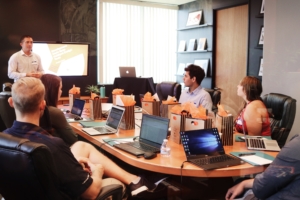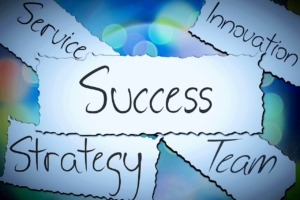How To Develop The Next Generation Of Company Leaders
By David Shaffer, MBA, Sr. Consultant
Finding and keeping great employees is getting increasingly hard. Your company’s ability to fight and win the ongoing talent wars hinges on your most important asset: your leaders.
by rawpixel
According to research in the Harvard Business Review, “Leaders who prioritize relationships with their employees and lead from a place of positivity and kindness simply do better, and company culture has a bigger influence on employee well-being than salary and benefits (“The Power of Healthy Relationships at Work,” June 21, 2022).
When it comes to attracting and retaining better employees, it comes down to leaders fostering positive relationships at work. But positive leader-employee relationships do not happen by chance.
Most managers weren’t born knowing how to create those positive relationships. But your organization should not suffer while your leaders learn by trial and error. In an age when there is an ever-escalating war for the better employees, it has never been more important for a business to invest in developing leaders.
This is why CEOs of privately owned companies in the $5 million to $100 million in revenue range and division heads of global organizations need to make sure to invest in training managers.
In other words, so one day they can confidently turn over the day-to-day management of the company to the next group of leaders. Here is a comeback story of a business owner who did just that.
How Fred Developed New Leaders
This is the tale of a 48-year-old business owner named Fred (not his real name), who created a small manufacturing company with annual revenues north of $5 million. On a personal note, Fred was a spiritual man who enjoyed being an active volunteer at his church.
On the job Fred had faith in his people and believed in them to work issues out. Unfortunately, that led to him being a victim of undeserved misfortune, His people loved working for Fred and knocked themselves out for him; however, as the adage states, haste makes waste.
Fred’s business problem was wasteful rework costs in excess of 35%, which meant that millions of dollars of the products required rework. That’s a tremendous amount of dollars that had to be absorbed by the business on a regular basis.
When Fred invited me in, I did an assessment to determine the root causes of the troubles. On the basis of that review as well as doing the LCS in-depth work style and personality assessment, we identified two solutions that needed to be implemented.
“On top of the rework nightmare, sales are dropping like a stone because all of the sales are being funneled through me, and I am totally consumed by the rework issue,” said Fred. “My sales team has been reduced to being order takers, not order generators. These are good people, and I do not know what to do.”
“We can fix this, Fred,” I told him. “It’s not going to be easy because you have some blind spots. You need to make some changes, but we can tackle the two needed solutions together.”
The first solution was a lean manufacturing process, which included quality control checks throughout the manufacturing process. That way, they could identify potential defects right at the point of the defect rather than at the end when it’s delivered to the customer.

By Mihai Surdu
That may sound like a very simplistic thing to do. However, understand that within the operation, there was a need to develop leaders who understood how to schedule the projects, communicate the goals to their team, and resolve issues with the people.
We conducted workshops for each of the shop supervisors, plus the shop foreman. We also brought in the sales team to talk about effective communication between sales and operations so that we could identify where time was being spent.
The second solution was to turn over the reins to the next generation. Eventually, we removed Fred as the owner from the day-to-day operations and put in place an executive team that included sales management, supervisors, shop foremen, as well as accounting to meet on a daily on what are the issues. We also did our LCS team building program, which includes using our LCS in-depth work style and personality assessment for the staff members. This provided me with insights into how to get the most from the team members as well as with helping them to bond and communicate with each other at a whole new level.
The net result was that the rework was reduced to 5% from 35%, and sales rose by 15% because now sales were not having to deal with the quality issues that were affecting sales. And here’s the kicker, Fred was a happier owner because it allowed him more volunteer time to lead bible study sessions at the church.
Seven Steps To Develop The Next Generation
With Fred, we followed these seven steps:
Step One. Maintain the mission, vision, and values that are a part of the company. The journey begins with an assessment of the DNA of the business.

by StockSnap
Step Two. Recognize the strengths that each person brings to the company. Leadership is not a birthright; it is about potential. So, test your people to assess leadership potential. Conducting in-depth work style and personality assessments can be extremely useful.
Step Three. Understand that leadership is something that is developed. Know this: leaders are not born; leaders are trained. Never has a baby been born, and the doctor slapped his or her bottom and declared, “Now here is a future company president.” Certain positive traits develop during a person’s life, which is a gift. But just relying on gifts and not training future leaders is a bad option for small-to-midsized companies.
Step Four. Dispel the belief that the best performers make the best leaders. Don’t make the classic blunder of just thrusting top performers into leadership roles. That is a 50/50 proposition at best. Once, I was a director of business process improvement and information systems consulting at one of the big accounting firms. The philosophy within the CPA firm was that you took your top-performing senior managers who were outstanding in doing tax returns, and you, therefore, promoted them to partner. Then we came to the realization that they don’t know how to be good at business development, a key requirement of a partner.
Step Five. Allow for creativity yet stay within the values of the company. People are not robots. And nor would you want them to be.
Step Six. Train leaders throughout all levels of management or job responsibilities. If you think training is expensive, then look at the costs of not training. Trained leaders make it easier for the company to fill jobs with the right people, retain top talent, and keep employees fully engaged. Today this is no easy feat, and paying more in wages and benefits is not the answer.
Step Seven. Introduce accountability and taking responsibility. Are you familiar with the “Miracle on Ice” with the US hockey team winning the Olympic gold medal in 1980? The underdog US team beat the Russians and made it to the finals to win it all. But if you really dig into the analysis of what happened, the coaches of that team took a bunch of individuals that were stars at different levels and molded them into a team. They achieved their goal of winning a gold medal by introducing accountability and taking responsibility.
Use A Three-Phase Approach
To optimize success, companies use a three-phase approach:

by Ronald Carreño
Phase One. Company Assessment And Understanding. This starts with meetings with executives and ownership to understand the company’s mission, vision, and values. Then comes outlining a key strategy for transition and personnel development. Follow this with preparing an objective assessment of the current environment, including gaps analysis to reach the desired structure. Next, we need to get everyone on board with the changes, so we prepare a presentation for review with key personnel.
Phase Two. Conduct A Workshop On Leadership And Accountability. Begin by reviewing components of leadership. Next, cover how to create an environment of accountability. Then cover the characteristics of effective communication. This is followed by a discussion of setting and achieving goals by leveraging talent and reaching individual potential. Lead the group to understand how to achieve team effectiveness. Nothing is ever smooth, so cover how to handle and resolve conflict. Finally cover the most effective means of coaching.
Phase Three. Continued Follow-up. This is not a case of setting it and forgetting it. Schedule one-on-one coaching sessions. Conduct group meetings to share experiences. And celebrate milestones that measure achievement.
Summing It Up
In my experience, privately owned companies are looking to put in place the next level of leadership within their company.

by free photos
The main goal is to allow the existing ownership to be able to have appropriate leaders developed within the organization that allows for the owner/manager to extricate themselves from the day-to-day business and still be in a position to provide high-level feedback on what’s going on within their company.
If you are open to a conversation about how to develop your next generation of leaders, or how our in-depth work style and personality assessment could help your team, please contact us at 310-453-6556, extension 410 or email us at pattyc@lighthouseconsulting.com and our website is www.lighthouseconsulting.com.
David Shaffer is our practice head for our Business Consulting For Higher Productivity Division for our ERP, M&A and process improvement practice. He is recognized for his ability to effectively integrate all aspects of the business, including financial management, information systems, infrastructure, sales management, sales strategies, and operations. David assists companies from planning through operational and business process improvement opportunities to the selection and integration of management information systems solutions. His range of company support includes start-ups through Fortune 500 firms.
Lighthouse Consulting Partners, LLC
Testing Division provides a variety of services, including in-depth work style & personality assessments for new hires & staff development. LCP can test in 19 different languages, skills testing, domestic and international interpersonal coaching and offer a variety of workshops – team building, interpersonal communication.
Business Consulting for Higher Productivity Division provides stress & time management workshops, sales & customer service training and negotiation skills, leadership training, market research, staff planning, operations, ERP/MRP selection and implementation, refining a remote work force, M&A including due diligence – success planning – value creation and much more.
To order the books, “Cracking the Personality Code”, “Cracking the Business Code” and “Cracking the High-Performance Team Code”, please go to www.lighthouseconsulting.com.
Permission is needed from Lighthouse Consulting Partners, LLC to reproduce any portion provided in this article. © 2024

















 An accurate assessment by a sales performance expert with detailed findings and recommendations
An accurate assessment by a sales performance expert with detailed findings and recommendations


 Lighthouse Consulting Services can help you take some time to review your culture and confirm if it fits not only the current personality of your organization but also the personality you want within the company. Together we can make sure that everyone understands the expected behaviors and how to create alignment with how to execute on them.
Lighthouse Consulting Services can help you take some time to review your culture and confirm if it fits not only the current personality of your organization but also the personality you want within the company. Together we can make sure that everyone understands the expected behaviors and how to create alignment with how to execute on them. The gas station metaphor is about eliminating a wasted trip. But in the business world, wasteful workflow processes are much less visible than that trip to the gas station. Historically, many businesses have learned to accept the non-value-added work throughout the enterprise. That is a gross miscalculation.
The gas station metaphor is about eliminating a wasted trip. But in the business world, wasteful workflow processes are much less visible than that trip to the gas station. Historically, many businesses have learned to accept the non-value-added work throughout the enterprise. That is a gross miscalculation. According to an opinion piece in The New York Times, Amazon is different than most businesses. Here is an excerpt from the article “The Secret of Amazon’s Success” that ran November 19, 2018 by economist William Lazonick, president of the Academic-Industry Research Network:
According to an opinion piece in The New York Times, Amazon is different than most businesses. Here is an excerpt from the article “The Secret of Amazon’s Success” that ran November 19, 2018 by economist William Lazonick, president of the Academic-Industry Research Network: Processes and workflows are similar, but they are not the same. A process is a set of repeatable activities that need to be continued to complete a specific goal that an organization has set. Workflow is series of repeatable activities that need to be continued to complete a specific task.
Processes and workflows are similar, but they are not the same. A process is a set of repeatable activities that need to be continued to complete a specific goal that an organization has set. Workflow is series of repeatable activities that need to be continued to complete a specific task. Streamlining is a journey, not just a onetime process. Your workflow processes might be improved by technology, but you are only as good as the team working the process.
Streamlining is a journey, not just a onetime process. Your workflow processes might be improved by technology, but you are only as good as the team working the process.
 As more people are vaccinated and the infection rate is decreasing, the talk is about moving back into the office toward that normal. Many leaders are inferring they will demand everyone return to the office while employees are wanting options. Some want to be able to work remotely a few days a week. Others want to work remotely full time.
As more people are vaccinated and the infection rate is decreasing, the talk is about moving back into the office toward that normal. Many leaders are inferring they will demand everyone return to the office while employees are wanting options. Some want to be able to work remotely a few days a week. Others want to work remotely full time.
 Developing a successful and lasting hybrid workforce takes building a new muscle. A muscle of enhanced communication, unique team building approaches, leaders driving the conversation and showing the way with a new focus and creating an offering that is attractive to existing and potential employees along with ensuring your customers continue to feel valued.
Developing a successful and lasting hybrid workforce takes building a new muscle. A muscle of enhanced communication, unique team building approaches, leaders driving the conversation and showing the way with a new focus and creating an offering that is attractive to existing and potential employees along with ensuring your customers continue to feel valued.
 The humor illustrated how much unproductive time employees typically spend at an office. The management challenge is to maximize productivity for the hours the employees work. Or is it?
The humor illustrated how much unproductive time employees typically spend at an office. The management challenge is to maximize productivity for the hours the employees work. Or is it?


 Regardless of the status of the current information technology, that is utilizing an existing system or entering into the selection process of a new one, it is essential that the TOM and value to be derived are clearly defined. That is, just how will we as an organization measure the ERP value and, equally important, how will our customers measure us to decide if we are in fact successful in implementing our strategy. In addition to this measurement is the strategic plan. It must be reflective of where we want the business to be and how we will measure our success.
Regardless of the status of the current information technology, that is utilizing an existing system or entering into the selection process of a new one, it is essential that the TOM and value to be derived are clearly defined. That is, just how will we as an organization measure the ERP value and, equally important, how will our customers measure us to decide if we are in fact successful in implementing our strategy. In addition to this measurement is the strategic plan. It must be reflective of where we want the business to be and how we will measure our success.